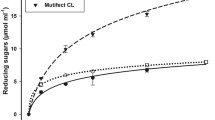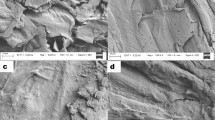Abstract
The polysaccharides in the primary plant cell wall are a renewable energy source for biofuel production. However, these polysaccharides are not readily available for bioconversion, and large enzyme sets are required to deconstruct them. Here, we aimed to improve the glucan conversion using recombinant hemicellulases and esterase as a treatment in exploded and sugarcane bagasses (SCB), followed by the addition of commercial CBH I to prevent its inhibition by hemicellulases products. A high secretion level of the recombinant enzymes was observed on SDS-PAGE. The highest activities were verified at a temperature and pH ranging from 40 to 55 °C and 4.5 to 6.0, respectively. The released reducing sugar analysis showed that all enzymes act better on SCB, with xylanase C (XynC) presenting the best activity (0.54 U/mg of protein). The high-performance liquid chromatography (HPLC) analysis demonstrated that 24 h of pretreatment was enough to reach maximum glucan conversion. The best synergy was achieved between XynC and CBH I on SCB, 1.4%. All results showed that the enzymes acted better on SCB, which can be related to the biomass composition and its molecular structure. The enzymatic pretreatment of SCB with XynC was essential to improve the glucan conversion by CBH I.






Similar content being viewed by others
References
Rezende CA, de Lima MA, Maziero P, De Azevedo ER, Garcia W, Polikarpov I (2011) Chemical and morphological characterization of sugarcane bagasse submitted to a delignification process for enhanced enzymatic digestibility. Biotechnol Biofuels 4:1–18
Santos FA, Queiróz JH, Colodette JL, Fernandes SA, Guimarães VM, Rezende ST (2012) Potencial da palha de cana-de-açúcar para produção de etanol. Quim Nova 35:1004–1010
Carpita NC (1996) Structure and biogenesis of the cell walls of grasses. Annu Rev Plant Physiol Plant Mol Biol 47:445–476
Scheller HV, Ulvskov P (2010) Hemicelluloses. Annual Rev Plant Biol 61:263–289
Heinze T (2015) Cellulose: structure and properties. Adv. Polym. Sci. In: Rojas O (eds) Cellulose Chemistry and Properties: Fibers, Nanocelluloses and Advanced Materials. Advances in Polymer Science, vol 271. Springer, Cham
Trache D, Hazwan Hussin M, Haafiz MK, Thakur VK (2017) Recent progress in cellulose nanocrystals: sources and production. Nanoscale. 9:1763–1786
Gupta PK, Raghunath SS, Prasanna DV, Venkat P, Shree V, Chithananthan C, Choudhary S, Surender K, Geetha K (2019) An update on overview of cellulose, its structure and applications, Cellulose. In: Pascual A R (ed) Cellulose, vol 1. IntechOpen, Lon
Carpita NC, Gibeaut DM (1993) Structural models of primary cell walls in flowering plants: consistency of molecular structure with the physical properties of the walls during growth. Plant J 3:1–30
Canilha L, Milagres AMF, Silva SS, Silva JBA, Felipe MGA, Rocha GJM, Ferraz A, Carvalho W (2009) Sacarificação da biomassa lignocelulósica através de pré-hidrólise ácida seguida por hidrólise enzimática: uma estratégia de desconstrução da fibra vegetal. Rev Anal 44:48–54
Wheals A, Basso LC, Alves DMG, Amorim V (1999) Fuel ethanol after 25 years. Tibtech. 17:482–487
Gray KA, Zhao L, Emptage M (2006) Bioethanol. Bioethanol Curr Opin Chem Biol 10:141–146
Lucas RC, Cereia M, Coral MA (2015) Large scale production of cellulases for biomass degradation. In Nascimento R (ed) Fungal biotechnology for biofuel. 1st edn. Bentham Science Publishers, Sharjah, U.A.E. pp316–328
Rana V, Rana D (2017) Use of commercial enzymes to boost on-site enzyme efficiency. In: renewable biofuels. SpringerBriefs in Applied Sciences and Technology. Springer, Cham, pp 87–104
Cellulosic Ethanol Novozymes Cellic® CTec3 - secure your plant’s lowest total cost. Novozyme. Novozymes A/S · Luna No. 2012–01394-01. 6/6. Application Sheet https://s3.amazonaws.com/zanran_storage/bioenergy.novozymes.com/ContentPages/2546502386.pdf .Acessed 09 Jan 2020
Oliveira TB, Gomes E, Rodrigues A (2015) Thermophilic fungi in the new age of fungal taxonomy. Extremophiles 19:31–37
McLaughlin DJ, Spatafora JW (2014) The Mycota 7, Systematics and evolution part A. Springer, Switzerland, Heidelberg
López SC, Sietiö OM, Hildén K, de Vries RP, Mäkelä MR (2016) Homologous and heterologous expression of basidiomycete genes related to plant biomass degradation. In: Schmoll M, Dattenböck C (eds) Gene expression systems in fungi: advancements and applications. Fungal Biology. Springer, Cham, pp 119–160
Ben Mabrouk S, Ayadi DZ, Ben Hlima H, Bejar S (2013) Thermostability improvement of maltogenic amylase MAUS149 by error prone PCR. J Biotechnol 168:601–606
Gomes E, de Souza AR, Orjuela GL, Da Silva R, de Oliveira TB, Rodrigues A (2016) Applications and benefits of thermophilic microorganisms and their enzymes for industrial biotechnology. In: Schmoll M, Dattenböck C (eds) Gene expression systems in fungi: advancements and applications. Fungal Biology. Springer, Cham, pp 459–492
Segato F, Damásio AR, Gonçalves TA, de Lucas RC, Squina FM, Decker SR, Prade RA (2012) High-yield secretion of multiple client proteins in Aspergillus. Enzym Microb Technol 51:100–106
Gonçalves TA, Damasio AR, Segato F, Alvarez TM, Bragatto J, Brenelli LB, Citadini AP, Murakami MT, Ruller R, Paes Leme AF, Prade RA, Squina FM (2012) Functional characterization and synergic action of fungal xylanase and arabinofuranosidase for production of xylooligosaccharides. Bioresour Technol 119:293–299
Kersters-Hilderson H, Claeyssens M, Van Doorslaer E, Saman E, De Bruyne CK (1982) Beta-D-xylosidase from Bacillus pumilus. Methods Enzymol 83:631–639
Miller GL (1959) Use of dinitrosalicylic acid reagent for determination of reducing sugar. Anal Chem 31:426–429
Faulds CB, Williamson G (1994) Purification and characterization of a ferulic acid esterase (FAE-III) from Aspergillus niger specificity for the phenolic moiety and binding to microcrystalline cellulose. Microbiology. 140:779–787
Bradford MM (1976) A rapid and sensitive method for quantization of microgram quantities of protein utilizing the principle of protein-dye binding. Anal Biochem 72:1105–1112
Gouveia ER, Nascimento RT, Souto-Maior AM, Rocha GJM (2009) Validação de metodologia para a caracterização química do bagaço de cana-de-açúcar. Quim Nova 32(6):1500–1503
Selig M, Weiss N, JI Y (2008) Enzymatic saccharification of technical lignocellulosic biomass. LAP, NREL/TP-510-42629 https://wwwnrelgov/docs/fy15osti/63351pdf Acessed 09 Jan 2020
Ichioka D, Itoh T, Itoh I (2001) An Aspergillus nidulans uvsC null mutant is deficient in homologous DNA integration. Mol Gen Genet 264(5):709–715
Skropeta D (2009) The effect of individual N-glycans on enzyme activity. Bioorganic med. Chem. 17(2): 2645–2653
De Castro AM, Pedro KC, Da Cruz JC, Ferreira MC, Leite SG, Pereira JRN (2010) Trichoderma harzianum IOC-4038: a promising strain for the production of a cellulolytic complex with significant beta-glucosidase activity from sugarcane bagasse cellulignin. Appl Biochem Biotechnol 162:2111–2112
Selig MJ, Knoshaug EP, Decker SR, Baker JO, Himmel ME, Adney WS (2008) Heterologous expression of Aspergillus niger beta-D-xylosidase (XlnD): characterization on lignocellulosic substrates. Appl Biochem Biotechnol 146:57–68
Paloheimo M, Haarmann T, Mäkinen S, Vehmaanperä J (2016) Production of industrial enzymes in Trichoderma reesei. In: Schmoll M, Dattenböck C (eds) Gene expression systems in fungi: advancements and applications. Fungal Biology. Springer, Cham, pp 23–57
Vogel J (2008) Unique aspects of the grass cell wall. Curr Opin Plant Biol 11:301–307
De Souza AP, Leite DCC, Pattathil S, Hahn MG, Buckeridge MS (2012) Composition and structure of sugarcane cell wall polysaccharides: implications for second-generation bioethanol production. Bioenerg Res 6:564–579
Acknowledgments
We are thankful for Dr. George Jackson de Moraes Rocha, from the Laboratório Nacional de Ciência e Tecnologia do Bioetanol (CTBE), who gave us the biomass used in this research. Dr. Mark R. Wilkins and Dr. Michael Mueller cordially provided laboratory support and help with the HPLC analyses that were performed in the Biosystems and Agricultural Engineering department at the Oklahoma State University.
Funding
This work was funded by the Brazilian CNPq fellowship (Grant No. 141133/2009-0) to RCL and the Fundação de Amparo à Pesquisa do Estado de São Paulo (FAPESP) post-doctoral fellowship to TBO (Grant No. 2017/09000-4).
Author information
Authors and Affiliations
Corresponding authors
Ethics declarations
Conflict of interest
The authors declare that they have no conflict of interest.
Ethical approval
This research did not involve human participants and/or animals.
Informed consent
All authors have read the manuscript and have approved the submitted version.
Additional information
Publisher’s Note
Springer Nature remains neutral with regard to jurisdictional claims in published maps and institutional affiliations.
Rights and permissions
About this article
Cite this article
de Lucas, R.C., de Oliveira, T.B., Lima, M.S. et al. Effect of enzymatic pretreatment of sugarcane bagasse with recombinant hemicellulases and esterase prior to the application of the cellobiohydrolase CBH I Megazyme®. Biomass Conv. Bioref. 12, 491–499 (2022). https://doi.org/10.1007/s13399-020-00719-9
Received:
Revised:
Accepted:
Published:
Issue Date:
DOI: https://doi.org/10.1007/s13399-020-00719-9




